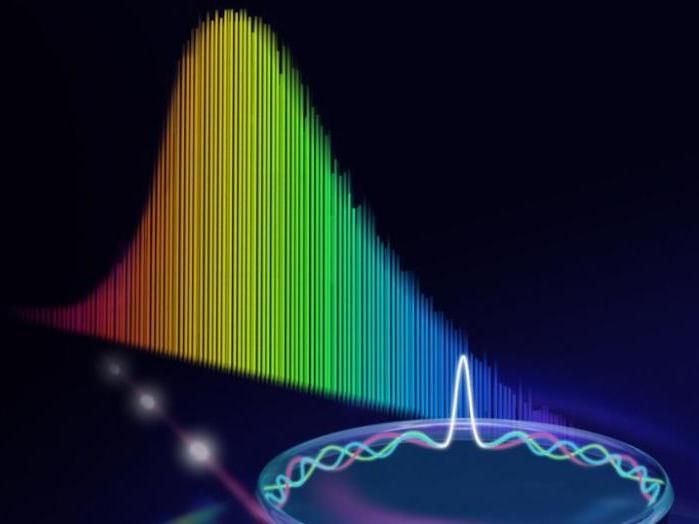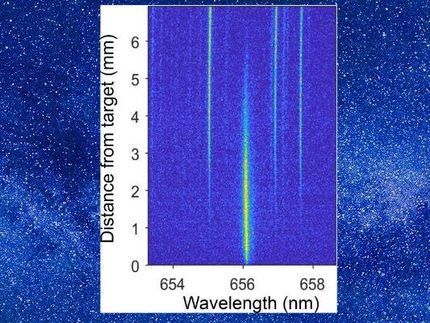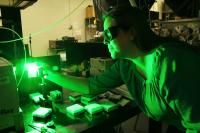Upgrading cheap diode laser for use in precise measurements
Russian physicists have developed a method for drastically narrowing the emission spectrum of an ordinary diode laser, like that in a laser pointer. This makes their device a useful replacement for the more complex and expensive single-frequency lasers, enabling the creation of compact chemical analyzers that can fit into a smartphone, cheap lidars for self-driving cars, as well as security and structural health monitoring systems on bridges, gas pipelines, and elsewhere. The study was co-authored by researchers from the Russian Quantum Center (RQC), the Moscow Institute of Physics and Technology (MIPT), Lomonosov Moscow State University (MSU), and Samsung R&D Institute Russia.

Physicists have developed a method for drastically narrowing the emission spectrum of an ordinary diode laser, like that in a laser pointer, for use in compact chemical analyzers that can fit into a smartphone, cheap lidars for self-driving cars, as well as security and structural health monitoring systems on bridges, gas pipelines, and elsewhere.
Pavlov NG et al./Nature Photonics
"This work has two main results," said the paper's lead author RQC Scientific Director Michael Gorodetsky, who is also an MSU professor. "First, it serves to show that you can make a cheap narrow-linewidth laser, which would be single-frequency yet highly efficient and compact. Secondly, the same system with virtually no modifications can be used for generating optical frequency combs. It can thus be the core component of a spectroscopic chemical analyzer."
The applications of lasers are many. Among them are laser eye surgery, laser sights, and fiber optic communication. One of the key uses of lasers is spectroscopy, which measures the precise chemical composition of virtually anything.
The so-called optical frequency comb technique underlies laser-based spectroscopy, pioneered by the 2005 Nobel laureates in physics, John Hall from the U.S. and Theodor Hänsch from Germany. The two developed a laser device that generates optical radiation at a million extremely stable frequencies. The radiation in the gain medium of such lasers "bounces" between mirrors and is ultimately emitted as a continuous train of brief pulses of light of a million different colors. Each pulse lasts mere femtoseconds -- millionths of a billionth of a second. The emission spectrum of such a laser consists of a great number of evenly spaced narrow spectral lines, the "teeth" of the optical comb.
An optical laser frequency comb can be used as a "ruler" to accurately measure light frequency and therefore make precise spectrometric measurements. Other applications include satellite navigation, accurate time data transfer, and the radial velocity method for detecting extrasolar planets.
It turned out that there is an easier way to generate frequency combs, which relies on optical microresonators. These are ring- or disk-shaped transparent components. By virtue of their material's nonlinearity, they transform pump laser radiation into a frequency comb, also referred to as a microcomb.
"Optical microresonators with whispering gallery modes were first proposed at MSU's Faculty of Physics in 1989. They offer a unique combination of submillimeter size and an immensely high quality factor," explained study co-author, MIPT doctoral student Nikolay Pavlov. "Microresonators open the way toward generating optical combs in a compact space and without using up much energy."
Not any laser can be used to pump optical frequency combs in a microresonator. The laser needs to be both powerful and monochromatic. The latter means that the light it emits has to fall into a very narrow frequency band. The most common and cheap lasers nowadays are diode lasers. Although they are compact and convenient, in spectroscopy they fall short of more complex and expensive devices. The reason is that diode lasers are not sufficiently monochromatic: The radiation they emit is "smeared" across a 10-nanometer band.
"To narrow down the linewidth of a diode laser, it is usually stabilized using an external resonator or a diffraction grating," explained Gorodetsky. "This reduces the linewidth, but the cost is a major decrease in power, and the device is no longer cheap, nor is it compact."
The researchers found a simple and elegant solution to the problem. To make laser light more monochromatic, they used the very microresonators that generate optical frequency combs. That way they managed to retain nearly the same laser power and size -- the microresonator is mere millimeters across -- while also increasing monochromaticity by a factor of almost 1 billion. That is, the transmission band is narrowed down to attometers -- billionths of a billionth of a meter -- and an optical frequency comb is generated, if required.
"As of now, compact and inexpensive diode lasers are available for almost the entire optical spectrum," added Pavlov. "However, their natural linewidth and stability are insufficient for many prospective tasks. In this paper, we show that it is possible to effectively narrow down the wide spectrum of powerful multifrequency diode lasers, at almost no cost to power. The technique we employ involves using a microresonator as an external resonator to lock the laser diode frequency. In this system, the microresonator can both narrow the linewidth and generate the optical frequency comb."
The proposed design has many possible applications. One of them is in telecommunications, wh ere it would considerably improve the bandwidth of fiber optic networks by increasing the number of channels. Another sphere that would benefit is the design of sensors, such as reflectometers used as the basis of security and monitoring systems. For example, if a fiber optic cable runs along a bridge or an oil pipeline, the light in the cable will respond to the slightest disturbances or variations in the geometry of the object, pinpointing potential problems.
Single-frequency lasers can be used in lidars, or optical radars, which are installed on self-driving cars, among other uses. Finally, the technology enables highly precise analyzers, such as those measuring the composition of air or running medical diagnostics, that could be integrated into smartphones or watches.
"The demand for such lasers would be really high," said Gorodetsky.
Original publication
Other news from the department science
Most read news
More news from our other portals
See the theme worlds for related content
Topic World Spectroscopy
Investigation with spectroscopy gives us unique insights into the composition and structure of materials. From UV-Vis spectroscopy to infrared and Raman spectroscopy to fluorescence and atomic absorption spectroscopy, spectroscopy offers us a wide range of analytical techniques to precisely characterize substances. Immerse yourself in the fascinating world of spectroscopy!

Topic World Spectroscopy
Investigation with spectroscopy gives us unique insights into the composition and structure of materials. From UV-Vis spectroscopy to infrared and Raman spectroscopy to fluorescence and atomic absorption spectroscopy, spectroscopy offers us a wide range of analytical techniques to precisely characterize substances. Immerse yourself in the fascinating world of spectroscopy!





























































